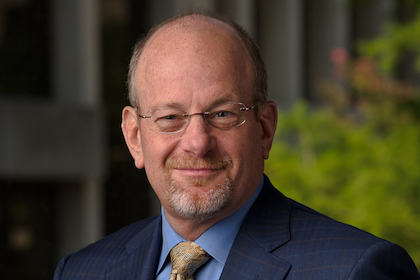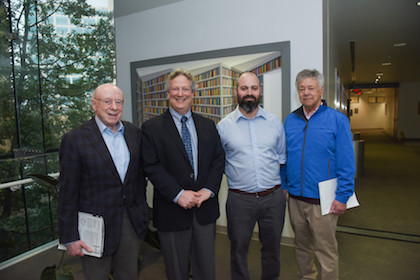A conversation with Dr. J. Gregory Fitz about new medical school curriculum
Dr. J. Gregory Fitz, Executive Vice President for Academic Affairs and Provost, and Dean of the Medical School, recently discussed UT Southwestern’s new medical school curriculum, which will guide the education of students beginning their studies in August 2015.
Why is UT Southwestern ’s medical school curriculum changing?
The existing medical school curriculum is excellent, and it’s a living document. So there has been active, ongoing creative work done from year-to-year to improve the curriculum.
In the process of that regular examination and change, we believed the time was right to take a bold, comprehensive look at the entire medical education experience at UT Southwestern . We were driven by a sense of obligation to do our best for students, so they’re well prepared for the rapidly changing world of medicine.
We also have an obligation to our patients. UT Southwestern is doing extraordinary work biomedical research, and we need to train our students about how that research is done and how to put that science to work in the clinical care environment, where it can help patients.
UT Southwestern has nearly doubled our clinical opportunities over the past 10 years, with new hospitals and programs. That makes it all the more important to think about how we can offer the best educational experience, utilizing all our different venues and our outstanding faculty.
Would you characterize the changes in the curriculum as the next phase in an ongoing evolution, or is it a more dramatic shift?
Curriculums do evolve, and ours has changed over time, but this is a bigger shift than we’ve had in the past. I would emphasize, however, that this is not an experiment.
The members of the curriculum committee, led by Dr. Dennis Burns, Professor of Pathology, and Dr. James Stull, Chairman of Physiology, were very thoughtful in their approach. They consulted curriculum leaders around the country, going to a number of institutions in person. They had innumerable conversations with faculty, administrators, students, and others. And they based the changes on proven principles and our own strengths as an institution.
For example, the new curriculum puts greater focus on team-based learning, individual contact with faculty over the course of a student’s medical education, meaningful mentorship opportunities, and balancing the hard science with the human side of medicine.
We also emphasize that every medical student is a student for life. There is an ever-expanding body of knowledge and new expectations in medicine. So a career in medicine – no matter what your specialty – means being a life-long learner.
Specifically, what are the most important aspects of the new curriculum?
I would make several key points about the new curriculum.
First, UT Southwestern is very focused on science-based medicine, in which every student masters certain core knowledge. With the new curriculum, the scientific component is intact, but taught in a very different way. The science is more fully integrated early in the course of study, but with the chance to come back later and revisit it, based on clinical experience in the interim. We think that’s a better way to learn the science that matters.
Second, as important as the science is, the new curriculum maintains an equal appreciation for the humanitarian components of medicine … how physicians talk with patients, how we deliver bad news, how we approach ethical dilemmas. There are many opportunities for students to have meaningful discussions and instruction in all of these areas. Our students are fortunate to encounter both referral patients, as well as a large underserved population through our service to Parkland Memorial Hospital. Both contribute to the student’s experience.
Third, from an individual standpoint, we want students to be their best, whether they’re practicing in a small town in Texas, serving in an urban environment, or doing high-end investigation as physician-scientists. And the new curriculum is designed to promote that kind of individual achievement.
The curriculum allows students to make decisions about what path they will follow earlier in their training, providing more opportunities to pursue specific tracks. So if you know you want to do primary care, or global health, or biomedical research, or public health you can optimize the use of your time in medical school to ensure you’re well prepared for those next steps. We have a large class – around 230 students per year – but each student is an individual with talents and passions to serve in different areas. We need to do our best as educators to facilitate those individual goals.
Finally, there is an increased expectation for academic accomplishment. By that I mean students should create new knowledge as part of the educational experience, furthering whatever specialty area they choose, and they should become critical thinkers so they can effectively evaluate scientific knowledge.
On your final point, how do you define creating knowledge, and why is critical thinking so important?
The creation of knowledge is defined very broadly. It could be focusing on health care quality and safety, for example, or more basic scientific endeavors. But, ultimately, medicine is a young field. There are only two generations of medicine in the modern era, since the introduction of penicillin. So medicine remains a discipline in transition. Part of our role as educators is to train students to constantly improve our profession.
Today, there is a doubling of medical knowledge every four to five years. There is one article published per minute in the medical sciences – and not all of that information is correct.
So, while we’re working to ensure that students are very well grounded in the facts of medicine and the experience of clinical care, we also want them to think critically and distinguish between what we know and what needs more investigation. That means they must ask hard questions, respectfully challenge the status quo, and think critically about a vast array of issues.
Does collaborative, team-based medicine help students become more discerning physicians?
We believe so. The best way to learn is by engaging in the process. Collaborative, team-based medicine brings the clinical, educational, and research sides of medicine together. As students work in teams, they’re better able to acquire and thoroughly evaluate data with the right minds looking at it.
Part of the excitement of medicine is that it is in an amazing period of convergence of science, technology, and important financial and demographic changes. Today, physicians deal with diverse patient populations, whether the differences are in patients’ beliefs, age, culture, or expectations of the medical system.
We need to equip students for these challenges, and that requires discussion, exposure, and examination. Working in teams enables members to bring their diverse experiences into the discussion and various viewpoints can be heard. Also, the structure of the colleges – which are made up of six or so students with a faculty mentor who meet regularly – is designed to promote discussion. Diversity of thought raises the consciousness of everyone involved, which helps people learn and adapt to unfamiliar situations.
You mentioned that current students and faculty members contributed to the new curriculum. Has this involvement provided benefits for them?
The curriculum committee was very outgoing, including literally hundreds of faculty members and students who have been engaged in critiquing and thinking through steps in implementing the new curriculum. One of the keys to success was this careful and thoughtful inclusion of so many individuals in so many groups.
I was very pleased to see how eager our current students were to put their thoughts and experiences into practice to create an ever-improving curriculum for future students. We’ll continue to learn and modify the new curriculum based on real-world feedback.
For our current students and faculty, the process of developing the new curriculum has already provided benefits – in terms of discussions about how lectures are given and the most effective way to teach and learn, about how the clinical experience should be monitored and improved, and about the difficult, sometimes sensitive, subjects that need to be discussed so students are prepared to deal with those challenges as physicians.
I think the process of developing the new curriculum has improved the experience of everyone involved – current students and faculty, as well as those who will follow in the future.
###
Dr. Burns holds the Jane B. and Edwin P. Jenevein, M.D., Chair in Pathology.
Dr. Fitz holds the Nadine and Tom Craddick Distinguished Chair in Medical Science, and the Atticus James Gill, M.D. Chair in Medical Science.
Dr. Stull holds the Fouad A. and Val Imm Bashour Distinguished Chair in Physiology.



